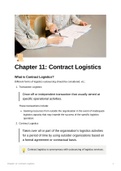Summary
Summary OBS 210 - Study Notes (Chapters 11, 13 and 14)
- Course
- Institution
- Book
This document includes all the work covered during the lectures, in lecture slides as well as the 3rd edition Strategic Logistics Management textbook. It also includes the class activities with full memos and explanations
[Show more]





